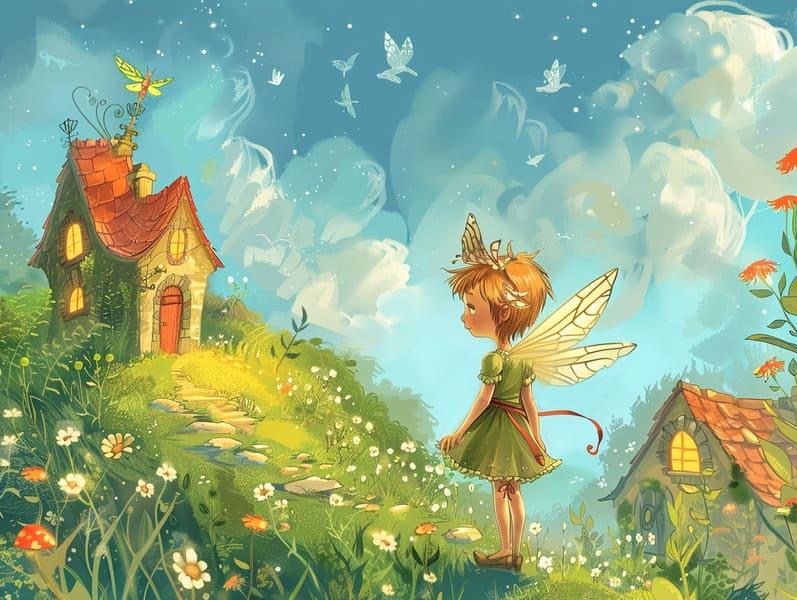
Old fairy tales have timeless appeal. These tales have been whispered from one generation to the next ages before they were ever written down. They came from a variety of traditions, including African traditions. They were initially transmitted among elders, often carrying themes and messages mirroring the societal norms and beliefs of the time.
The renowned Brothers Grimm, Jacob and Wilhelm Grimm, were among the first to collect many of these beloved stories. Their compilation, "Grimm's Fables," included narratives like "Cinderella," "The Story of Hansel and Gretel," and "Snow White," which have since become classics in the world of traditional fairy tales. Similarly, Andersen's imaginative stories, such as "The Little Mermaid," and "The Ugly Duckling," have captivated hearts worldwide, cementing their place in the pantheon of famous fairy tales.
Despite being ancient, these stories remain as significant as ever, especially as children's bedtime stories. These delightful tales are now available in various formats, including vibrantly illustrated books, delightful animations, and digital fairy tales.
Their lasting presence can be traced to several captivating elements:
Crucial Morals: Old fairy tales often offer important moral lessons. Narratives like "The Tale of the Boy Who Cried Wolf" teach the virtue of being truthful, while "The Race of the Tortoise and the Hare" stress the traits of tenacity and humility. These narratives offer the young clear distinctions between moral and immoral, building their moral compass in a tender yet lasting way.
Empathy and Awareness: Fairy tales frequently illustrate characters facing trials and tribulations, urging listeners to sympathize with their struggles and support their triumphs. For instance, "Beauty and the Beast" conveys the significance of valuing inner qualities to understand the real person of a person, promoting warmth and insight.
Cultural Understanding: Many traditional fairy tales are imbued with the cultural contexts from which they originated. Exploring these tales can provide informative snapshots into different backgrounds, advancing a sense of global respect and discernment.
Fantasy and Innovation: The fantastical elements in classic fairy tales—magical kingdoms—fire up children’s creativity. These tales lead readers to extraordinary realms, motivating inventive thinking and a sense of mystery that remains a lifetime.
Classic fairy tales are not only captivating but also pedagogical. They function as enchanted tools in cultivating various thinking and feeling skills in little ones. When timeless fairy tales are read aloud, they advance speaking abilities by bringing new language items and complicated sentence structures. This practice also develops auditory perception and attentiveness, as little ones keep up with the story, looking forward to see what happens next.
Furthermore, debating the themes and characters of timeless fairy tales can promote logical thinking and critical thinking. Young ones are guided to detect patterns, forecast, and make sense of cause and effect. These explorations also advance young readers voice their thoughts and feelings, strengthening their emotional intelligence.
In today’s electronic age, the prevalence of internet fairy tales has made these fairy tales more available than ever. Digital sites and web apps make available extensive collections of popular fairy tales that can be seen or listened via anytime, anywhere. Fairy tales read out loud are particularly prevalent, presenting an immersive method for young readers to experience these alluring stories. Audiobooks and spoken videos move characters and settings to life, often joined by magical audio effects and instrumentals that amplify the story journey.
The unending appeal of old fairy tales lies in their ability to adjust to modern society while preserving their fundamental ideas. Contemporary revisions of these fairy tales often include more representative protagonists and modern settings, making them familiar to today’s audience. However, the main ideas of gallantry, empathy, and equity remain unchanged, continuing to impact readers of all ages.
Classic fairy tales also offer a sense of solace and recognition. They present to a organized narrative with a apparent beginning, middle, and end, often finishing with the culmination of conflicts and the triumph of virtue over vice. This constancy can be placating for young readers, sharing a sense of reliability in an unpredictable world.
Ancient fairy tales continue to enchant and guide new generations, maintaining their spell and relevance in modern society. As children's night stories, they more info afford a perfect blend of enchantment and education, encouraging moral values, empathy, and creativity. The accessibility of internet fairy tales and the widespread nature of fairy tales voiced certify that these ancient fairy tales remain available to new generations.
By retaining and disseminating these fairy tales, we continue to admire the rich tapestry of myths and cultural heritage. Whether you are viewing a vividly illustrated book, accessing a virtual collection, or listening through an narrated book, the elegance of Grimm's fairy tales is always within reach. These narratives illustrate of the immortal ability of storytelling and its ability to tie us across centuries and lands.
If you are enjoying a artistically illustrated book, accessing a internet collection, or playing an audiobook, the attraction of popular fairy tales is always within reach.
These narratives show us of the unending presence of stories and its ability to bind us across time and space, casting a charm that enchants and educates alike.